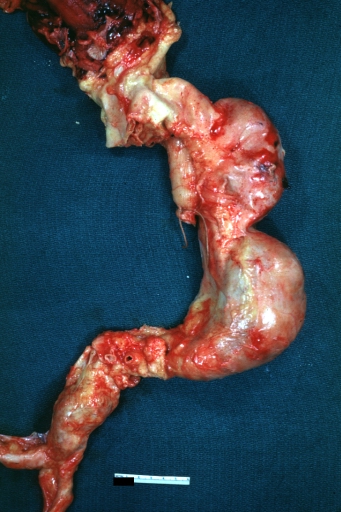Aortic aneurysm: Difference between revisions
No edit summary |
No edit summary |
||
| Line 17: | Line 17: | ||
}} | }} | ||
'''For patient information click [[ | '''For patient information on Thoracic aortic aneurysm, click [[Thoracic aortic aneurysm (patient information)|here]]''' | ||
'''For patient information on Abdominal aortic aneurysm, click [[Abdominal aortic aneurysm (patient information)|here]]''' | |||
{{CMG}}, '''Associate Editor-In-Chief:''' {{CZ}} | {{CMG}}, '''Associate Editor-In-Chief:''' {{CZ}} | ||
==Overview== | ==Overview== | ||
An '''aortic aneurysm''' is a general term for any swelling ('''dilatation''' or [[aneurysm]]) of the [[aorta]], usually representing an underlying weakness in the wall of the aorta at that location. While the stretched vessel may occasionally cause discomfort, a greater concern is the risk of '''rupture''' which causes severe pain, massive internal [[hemorrhage]] and, without prompt treatment, results in a quick death. Aneurysms often are a source of blood clots ([[embolus|emboli]]) stemming from the most common etiology of atherosclerosis. | An '''aortic aneurysm''' is a general term for any swelling ('''dilatation''' or [[aneurysm]]) of the [[aorta]], usually representing an underlying weakness in the wall of the aorta at that location. While the stretched vessel may occasionally cause discomfort, a greater concern is the risk of '''rupture''' which causes severe pain, massive internal [[hemorrhage]] and, without prompt treatment, results in a quick death. Aneurysms often are a source of blood clots ([[embolus|emboli]]) stemming from the most common etiology of atherosclerosis. | ||
Revision as of 21:47, 28 October 2012
| Aortic aneurysm | |
 | |
|---|---|
| Atherosclerotic Aneurysm: Gross, an excellent example, natural color, external view of typical thoracic aortic aneurysms Image courtesy of Professor Peter Anderson DVM PhD and published with permission © PEIR, University of Alabama at Birmingham, Department of Pathology | |
| ICD-10 | I71 |
| ICD-9 | 441 |
| OMIM | 100070 |
| DiseasesDB | 792 Template:DiseasesDB2 Template:DiseasesDB2 |
| MeSH | D001014 |
For patient information on Thoracic aortic aneurysm, click here
For patient information on Abdominal aortic aneurysm, click here
Editor-In-Chief: C. Michael Gibson, M.S., M.D. [1], Associate Editor-In-Chief: Cafer Zorkun, M.D., Ph.D. [2]
Overview
An aortic aneurysm is a general term for any swelling (dilatation or aneurysm) of the aorta, usually representing an underlying weakness in the wall of the aorta at that location. While the stretched vessel may occasionally cause discomfort, a greater concern is the risk of rupture which causes severe pain, massive internal hemorrhage and, without prompt treatment, results in a quick death. Aneurysms often are a source of blood clots (emboli) stemming from the most common etiology of atherosclerosis.
There are 2 types of aortic aneurysms:
- Thoracic aortic aneurysm (TA), which occur in the thoracic aorta (runs through the chest)
- Abdominal aortic aneurysm (AAA), which occur in the abdominal aorta, are the most common.
Aneurysms that coexist in both parts of the aorta are termed thoracoabdominal aneurysms (TAA).